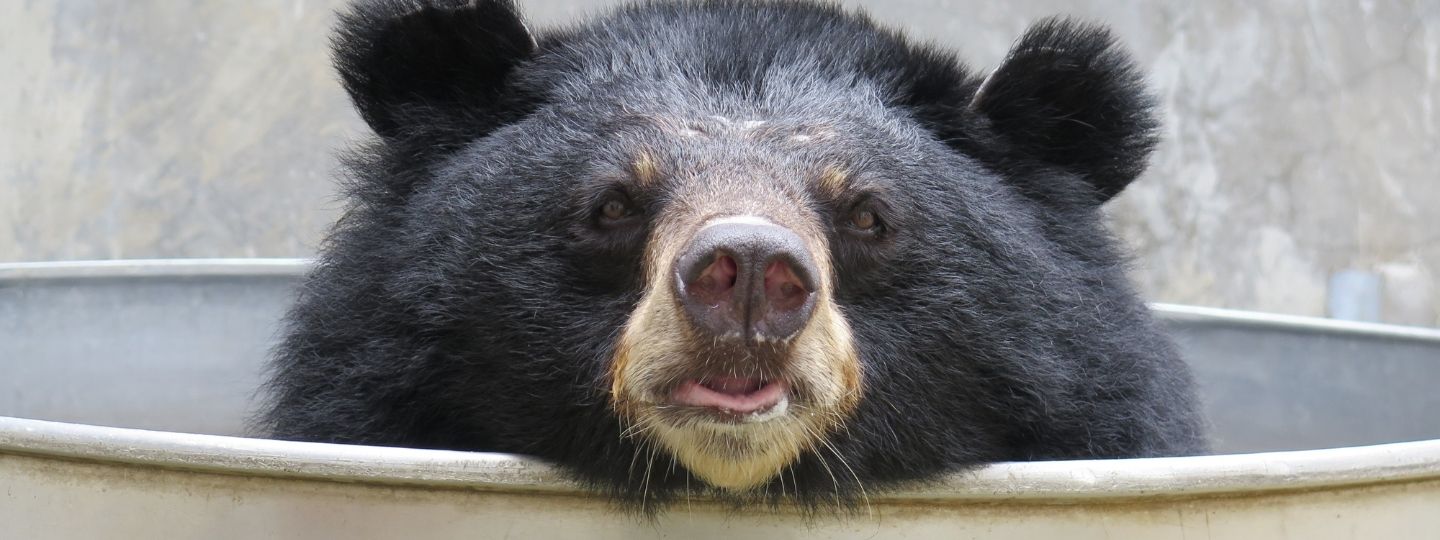
Healing trauma in bears: in depth
What does it take to help a traumatised bear heal?
Emotional healing takes time. And for the most traumatised bears, it begins with small, carefully supported steps. At Animals Asia, we use a five-phase trauma recovery approach rooted in trust, choice, and consistency.
This page offers a deeper look at how we support behavioural healing, from early desensitisation to the development of healthy routines, helping each bear rediscover their own rhythm, confidence and sense of peace.
Rescuing bears and giving them a second chance at life is incredibly life-affirming.
There’s nothing more moving than seeing them explore, learn about their environment, make friends, and – often for the first time in their lives – simply be bears. But this transformation doesn’t happen overnight. Many carry deep psychological scars that make it hard for them to understand that they are finally safe.
Instead of reacting to their surroundings like other animals might, traumatised bears often display repetitive behaviours, exaggerated fear responses, and difficulty interacting with other bears. These are signs of trauma – something that affects not just people, but animals too.
What is trauma?
Trauma is a term used to describe the physical, mental and emotional damage caused by long-term or extreme stress. Animals, and people, can usually handle short periods of stress. These experiences, while unpleasant, can help us learn and adapt. But when stress continues over a long time, it becomes harmful. It can actually change how the body and brain function.
When this happens, animals can lose their ability to react in a helpful or healthy way. This is when we start to see behaviours in bears that look like anxiety or fear, even when they are safe.
How do bears experience trauma?
Bears are highly intelligent animals. They have complex thoughts, feelings, and ways of communicating. Because of this emotional depth, they suffer greatly when exposed to pain, fear and isolation.
Most of the bears who come to our sanctuaries have experienced trauma. Each bear responds differently, depending on their genetics, personality and past experiences.
While many of these challenges are expected in the first few weeks or months after rescue, trauma can cause problems that last for years – even after they’ve lived in safety for a long time.
Do bears ever fully recover from trauma?
One of the most important lessons in helping bears heal is accepting that ‘full recovery’ isn’t always possible. Trauma runs deep – sometimes right down to the body’s cells – and it doesn’t just disappear. And that’s okay.
What matters is progress. Healing isn’t a straight line. The goal is to help each bear move in the right direction and to support them through the ups and downs.
Sometimes, a bear who seems fine can suddenly show signs of fear or stress years after rescue. That’s just the nature of trauma.
What does healing look like?
Helping traumatised bears involves understanding their needs and going at their pace. No single plan works for every bear, but there are five key steps we always follow:
1. Build and maintain trust
Healing starts with trust. For many bears, people were a source of pain and fear, so showing them that we aren’t going to hurt them is essential. Caregivers use calm voices, consistent and regular routines, and positive experiences to show the bears they are now safe.
A strong bond between a bear and their caregivers helps them feel more secure and more able to learn. It also makes them less likely to act out in fear or aggression.
2. Remove or reduce stressors
In order to begin to heal, bears need a calm and stable environment. We try to identify anything that might be causing them stress and remove it. This could be a sound, a smell, a sight – or even something we humans can’t sense.
Some bears have developed habits like pacing or sudden aggression because they are so used to being in danger. Even when they’re safe, they might still feel threatened. So we carefully manage their environment to help them stay calm.
3. Manage emotions
Even in a peaceful sanctuary, some bears continue to struggle. If changing the environment isn’t enough, we sometimes use medication to help them manage their emotions.
Just like humans, it’s hard for bears to learn when they feel overwhelmed by fear. Medication can help reduce anxiety, improve mood, and prepare their brains to accept new, positive experiences.
Once a bear starts feeling safer, they are more able to explore, play, and learn. That’s when deeper healing can begin.
4. Teach new behaviours
When a bear is ready, we start teaching behaviours that help them cope with stress. This might mean slowly introducing them to something that used to scare them – like another bear or a new space – while helping them feel calm.
We use reward-based training, encouraging behaviours we want to see and gently discouraging those that aren’t helpful. Each bear moves at their own pace, and we always pay close attention to their body language. Their comfort and emotional state guide every decision.
5. Go slowly
This final step might be the most important.
Healing from trauma takes time. Sometimes, even a small change can be overwhelming. So we take our time. We give bears space to adjust, and we let them tell us when they’re ready for something new.
Even after years of safety, a rescued bear might still react strongly to certain situations. That’s why we continue to support them for the rest of their lives.
Helping bears heal from trauma is a long, delicate process. But with patience, structure and loving care, bears can rebuild their lives. They can form friendships, feel joy, and live the peaceful, natural lives they were always meant to have.
